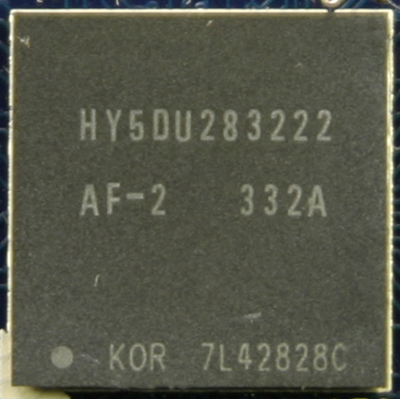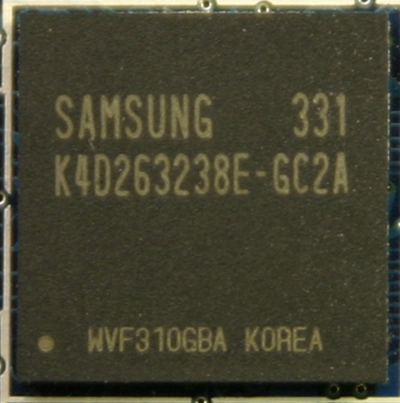Memory Modules
Before DX9 cards came along, memory speed and bandwidth were all important. There were plenty of instances in which GPUs were starved for action because they weren't able to get data fast enough. Now, though, raw computing power is presenting itself as the main driving force behind high quality graphics. The reason for this is that some cool effects, which used to be done with a memory trick, can now be done programmatically with pixel and vertex shaders. This doesn't mean that having fast memory is unimportant (we still need to move a high volume of data), and we are going to try to get as much data flowing as possible for this review.The two memory makers that we are going to see coming to the plate in this roundup are Samsung and Hynix. On both ATI's and NVIDIA's top end cards, we are seeing Hynix GDDR-II modules on board, while the mid-range products are outfitted with the Samsung parts.

Hynix 2ns Ram Module
The high-end Hynix HY5DU283222 and Hynix HY5DU573222 are used on NVIDIA 59xx and Radeon 98xx cards, respectively. NVIDIA requires 2ns RAM for its 5950 cards to hit a 950 MHz data rate, while ATI only needs the 2.5ns modules, as it doesn't need more than an 800MHz data rate. The NVIDIA GeForce FX 5900 that we tested sports 2.8ns Hynix RAM rather than the 2ns of the 5950s.

Samsung 2.8ns Ram Module
RAM for the Radeon 9600XT tops out at 700MHz effective rate speeds, which is more than enough room to hit the reference specification of a 600MHz data rate. The Samsung RAM that NVIDIA employs is a bit faster at 2.2ns, and we have seen some cases where this RAM ran stable beyond the 900MHz data rate, which should have been its limit.
The modules themselves have a great deal to do with how fast the memory on a graphics card can be run, but beyond the simple specs of the memory itself, performance is affected greatly by board layout, latency settings, and cooling. All of these aspects are controlled by the OEM, and all of them have a large impact on how well memory on a card will overclock.
The first thing that we had hoped for when we saw that Crucial had entered the graphics card market was that they would equip their cards with their own RAM. Unfortunately, that's not the case, as all the cards that we've seen from them follow suit with the other cards in their category.
Since we aren't seeing any variation on what RAM OEMs are pairing GPUs, the variances in RAM speed among similar cards will be due to the aspects that we mentioned before, as well as a little luck of the draw (overclocking isn't an exact science, and every single part is unique even if its from the same batch of chips).










44 Comments
View All Comments
vss1980 - Wednesday, March 10, 2004 - link
I'm surprised there weren't more DirectX9 games tested.I must admit its annoying when review sites test with only 1 or 2 older games and focus on just 3Dmark and new game tests, but considering all those cards are DX9 cards the lack of DX9 testing isn't right.
anthonyv - Monday, March 1, 2004 - link
please recheck the charts on p.25... I think the charts, chart titles, and text are mixed up.Cheers,
..anthony
Atlas5 - Sunday, February 29, 2004 - link
I'm not sure that a comparison of such limited depth is all that useful to someone trying to figure out if upgrading to a new card is worthwhile. Try this review...http://www6.tomshardware.com/graphic/20031229/inde...
...if you're looking to compare more than what's hit the streets in the last 9 months.
mkseidl - Thursday, February 19, 2004 - link
You can d/l the coolbits reg edit which will add a tab to your display settings to overclock the video card with simple sliders. Just to compare with your FFXI my score was 3800 :)(I haven't run the benchmark with my card oc'd)I have
Asus a7v8x
xp1700 @ 2.25ghz
evga geforceFX 5900se
1gb pc2100
sata raid 0 array 240gb
dvd +/- burner
lian li case
I have a question, on hot hardware they got their evga up to 471/871mhz
But I can only gt mine up to 429\820
which is about a 50mhz diff? is that average for cards? I know not all cards/procs can oc the sae. but shouldn't it be closer?
Martin
mkseidl@hotmail.com
mincheng - Wednesday, February 18, 2004 - link
Can anyone tell me how to overclock the video cards??? I know that when you OC a cpu you gotta go to BIOS, but I just don't understand how Video Card overclocking works? I currently own a PNY FX5600 Ultra and a P4 3.06Ghz/533L2Cache - overclocked to 3.45Ghz and a 1Ghz of PC800 RDRAM. Scored 3437 on FFXI benchmark ver.2 . I really want to OC my video card so I can get better speed. And if you know how to OC then can you please e-mail me at hhsu@socal.rr.com? THANKS!mkseidl - Wednesday, February 18, 2004 - link
Just out of curiosity, how did you guys overclock the video cards? I can't find anything in my drivers or bios to overclock my card. After reading your benchmarks, I purchased a evga 5900se. I upgraded from Gefoce2 Ultra3dMark01 - Geforce 2 was 5013 and my Fx was 9109
Is that a big jump?
And in the FFXI benchmark I went from 1900 to 3800
But I want to overclock the crap out of it like my proc ;)
Martin
Pete - Wednesday, February 11, 2004 - link
Last nitpicks: box shots and bundle listings would have been useful, and part numbers and stock speeds should have been mandatory on each card's page. Considering most vendors offer multiple versions of each product, not clearly marking which card was tested in this overclocking roundup seems like a rather glaring omission. NewEgg now seems to offer a High Tek (HIS) 9600XT, but I can't tell if that's the same one as in your review, or even if stock memory speed for HIS cards is 600 or 650MHz. Your only mentions of memory speeds are at the ends of pages 15 and 16, somewhat removed from each card's product page. I think it would have much clearer and more helpful if you had mentioned that both Sapphire's and HIS' 9600XT's ship with their memory at 650MHz either in their product pages, or directly under the memory overclocking graph.Pete - Sunday, February 8, 2004 - link
Derek, Indig0's reply is slightly worying. I hope people aren't getting the wrong impression of anyone's performance based on a single sample's overclocked performance in only three benchmarks. If the samples were sent to you by each AIB, that's even more worrying, as who's to say they weren't cherry-picked?In fact, not indicating both the clock speeds and the fact that the cards were overclocked on each benchmark graph seems like a gross oversight. If the Flash format is preventing you from doing so, then changing it should be a priority. But if you can add two lines of description for each card (which it looks like you have plenty of room for), I'd amend the review.
For future overclocking reviews, I think it'd be much more useful to at least show the percentage improvements in both clock speed and framerate in the game benchmark charts. Sure, you've covered this earlier in the article, but it's a long article, and there's no point in forcing people to continually flip back and forth when it's relatively simple to add this data to the graphs. Ideally, I'd have liked to see two graphs for each card, one for stock and one for OC'ed speed, with the clock speeds in the card title and the percent improvement over stock speed right after the OC'ed speed bar. I think you can cram a lot more useful data into those graphs. :)
Stlr22 - Sunday, February 8, 2004 - link
I would love to see benchmarks at 1600x1200. That's the sweetspot that I always play games at so I'd would like to see what kinda CPU/GPU combo it's gonna take to get smooth game play at that level.
Nemesis77 - Friday, February 6, 2004 - link
This review is getting alot of flack from the folks at Beyond3D: http://www.beyond3d.com/forum/viewtopic.php?t=1013...